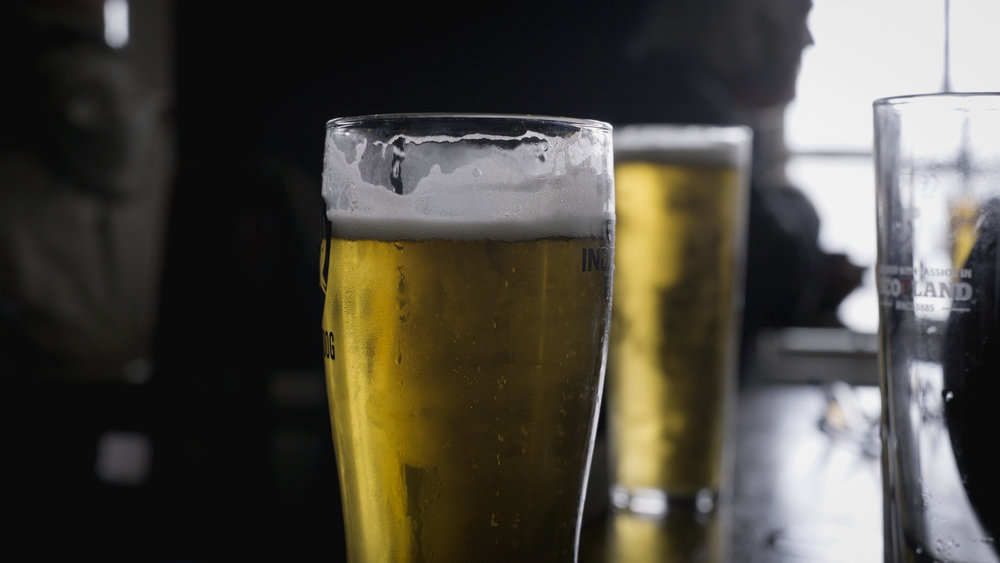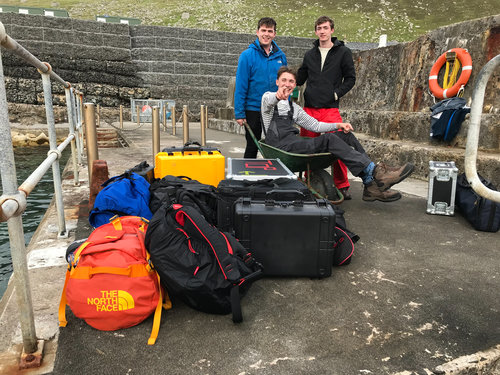Almost exactly two years ago, box player extraordinaire and famously tall person Joseph Peach invited me round to his flat to discuss the logistics and practicalities of transforming an idea he had into a film. The film was to follow a tall ship on it’s voyage round some very hard to reach islands, and at the end of the trip there would be a concert held in the highly unlikely setting of the church on St Kilda. I explained that while the film was almost definitely possible, you would need a few technically minded pairs of hands to help and the kind of financial support that only absentee landlords or eccentric sheiks would be able to provide. Some hours later, I left Joseph’s Cessnock flat dosed up to the nines with coffee and feeling sympathetic that he had become so attached to an idea that was essentially impossible without the limited might of a television budget at your back.

As such I was enormously surprised when I was awoken one morning the following summer by the unfamiliar pitching of the Wylde Swan, a tall ship which was at that moment rolling far from land in the Atlantic swell. Armed only with an unrobust beanie and a small Sony mirrorless camera, I had been charged with filming the travels of the exceptionally creative and bafflingly resourceful traditional music duo, Charlie Grey and Joseph Peach. Their quest would see them travel to some of Scotland’s most remote islands before performing a suite of music based on the human history of these places, in what was surely to be the most remote performance of the summer.
We set off from Ullapool Harbour at 6pm on the 24th of August, having spent the previous few hours drinking pints of IPA in the Ferry Boat Inn for lack of anything more productive to do. With the number of tricks we could each do with beer mats far exceeding our collective knot vocabulary, we decided our best bet was to load our bags onto the ship and then while away the remaining hours on land far away from the crew, for their own safety as much as our own. Later, as Ullapool disappeared into the stern of the boat, framed by a predictably picturesque Loch Broom sunset, each member of our party did their best to appear awed while figuring out who would last the longest before succumbing to sea-sickness. Delightfully, this proved a problem I would not have to contend with while on board, though I am certain everyone involved would plead a similar case.

We were to spend all of that first night and most of the following morning heading directly West, deviating from course just long enough to avoid crashing into Harris. While we ate lunch the following day and adjusted to the constant risk of plates sliding from our grasp and onto the floor, St Kilda drew itself up from the horizon, presenting a jagged array of sea stacks which were beautiful and intimidating in equal measure. It’s easy to imagine that without the luxury of a live aboard chef and central heating that these behemoths might seem more terrifying than enchanting.
The closer we drew to the bay, the more visible the MOD presence on the island became. This tempered our total amazement at the local geology with slight annoyance that the British army still felt the need to stake it’s claim at the far edge of the Hebrides, reducing one of the country’s wildest and most rarely visited places to a defunct missile outpost. Nonetheless, our enthusiasm for the task at hand could not be quelled and by the time we dropped anchor in Village Bay our excitement had long since bubbled to the surface.
Once we were fed and suitably immobilised by unwieldy buoyancy aids we began the nerve-wracking process of lowering thousands of pounds of camera equipment and musical instruments into inflatable boats already weighted with temperamental petrol engines. Minutes later, satisfied that our gear had made it onto the island as dry as it had started the day, we repeated the journey ourselves, aiming for the pier and the wheelbarrow upon it that would help us carry hundreds of kilograms of technology, wood and reeds to the stage door.


Once we had transported all our equipment into what was to be the concert venue, we took stock of the room that would form the basis of the film. The simply appointed church had also served as the schoolhouse, and the books and ink used by the pupils are still to be found sitting on desks in the next room, a fascinating and vivid insight into the lives of a people who have only just passed from living memory. Despite this I elected not to dwell on the generations of St Kildans for whom the building had formed part of everyday life, as I was fairly certain that this group of islanders, who for a spell stood out as staunchly Presbyterian even among their neighbouring islanders, would have been incandescent with rage to see their church cum schoolhouse used for such frivolous purposes. The least severe punishment we could have hoped for would have been a few choice cracks of the belt which, conveniently, was within easy reach of my first camera position below the pulpit.
We were sharing our trip with about thirty other people who, rather than venturing to an island in the sun or inspecting the Caribbean from the deck of an ocean liner had elected to come aboard the Wylde Swan for a week. This in itself reveals a lot about the character of the average person aboard the ship, and luckily our generous and patient studio audience was comprised almost entirely of these intrepid souls. With the church as full as it would have been at the height of the St Kildans religious fervour, Charlie and Joseph embarked on a half hour long performance which was impossible to divert your attention from, incredibly expressive and utterly captivating. Unless you were trying to get as many passes as you could on camera before it got dark while multitracking audio, in which case it felt like a fringe event. Having said that, even with several minor technical gripes gnawing at me, the music they performed left me stunned and they should be richly rewarded for composing such a unique and moving body of work.

On our way back to the boat, a crew member, Charlie and I became stranded halfway between the pier and the Wylde Swan. The cable responsible for getting petrol to the engine of our tender had snapped in two, and while our predicament would be considered dangerous by only the most mild-mannered spectator, the situation left me with plenty time to contemplate whether I had sufficiently documented a place that had been on my mind for years. I began to wonder whether there would even be any footage left when I checked or if my lightning fast Sandisk cards would have been reduced to useless bits of salty plastic by the sea spray. As such, by the time we arrived back in our cabin I was thoroughly in favour of getting to know our shipmates better and investigating the supply of whisky they had taken on board, with some evidently anticipating being stranded at sea for several months.
This sequence of events established a very satisfying pattern which was to be repeated each subsequent day. An overnight course running into the morning which would allow us to explore a new island each afternoon, with every destination seemingly more inspiring and less accessible than the last. Apart from Lochboisdale, which was very much as expected. Over the course of the journey, I was able to manage my constant fear that I was not capturing enough footage during the day by exchanging grain alcohol and lies about my life on land with others on the boat by night, arguably creating a self-fulfilling prophecy.
It was not until our penultimate day aboard the ship that I would finally be satisfied that there was enough in the can to make something worthwhile. We arrived on the Shiants about forty five minutes before sunset, leaving just enough time to hoover up some general views of the island before using the glorious light to film some tunes inside the small hut on Eilean an Taighe. The island features a small bothy that was once used by Compton MacKenzie as a bolt hole for writing, and which is decorated in the standard style befitting a Scottish wilderness refuge. Lamps are foregone in favour of candles melted into empty bottles of Laphroaig, while the pantry is stocked with a dazzlingly strange array of canned goods left by kayakers. OS maps that look thoroughly out of date are bundled in the corner of a bookshelf and the skull of a ram sits above the fireplace, enough of a deterrent that only the clinically odd would wish to outstay their welcome.

In the dying light of the day we filmed a set of tunes that beautifully captured the melancholy atmosphere surrounding our trip home. Over the past week, deprived of any useful phone signal and stripped of all distractions, each of us found our omnipresent millennial dread fading and being replaced with a sense that maybe life on the high seas would suit us. Perhaps risking crossing paths with highly trained counter-piracy units was a fair price to pay for absolute calm. I even got so far as to wonder whether I might be able to train one of the nearby nesting puffins to parrot my most threatening mannerisms before the ferocity of the midges dragged me from my reverie. As Joe and Charlie completed their final interview perched outside Mackenzie’s old haunt, the sole sheep on the island shuffled past, making it clear that whoever was in charge of its shearing had long since sold their means of travel to the island.
That night we shared a three course meal with the full complement of crew and passengers, and I can only assume that afterwards rumours began to circulate of a new tax or duty that would be levied on any leftover spirits as soon as we returned to shore. A gentle cruise back to Ullapool the following day from our overnight anchor next to the densely populated sea cliffs of Garbh Eilean presented ample opportunity for contemplation, as the bow effortlessly sliced through the placid waters of the Minch. The scale and immutability of the islands we had visited served as a potent reminder that almost nothing we do has any real consequences: morbid, but comforting all the same. This is slightly ironic as I would spend the next few months tearing my hair out in post-production, but for now I was blissfully savouring my maritime epiphany.

On the whole I am happy with the film. At points, the driving Atlantic wind lashing off radio mics makes me wince, and at others the unforgiving midday sun forces me to squint. However, there are pictures which successfully convey the vastness of the Atlantic, sequences which portray well the character of the subjects and the beauty of the Hebrides is delightfully apparent in places. I hope the film will allow viewers to follow lightly in Joe and Charlie’s footsteps, to places that are less well travelled than some of the world’s highest peaks. While it is important not to romanticise the gruelling subsistence lifestyle of the people who lived on these islands, it is hard to resist the astonishing natural beauty and complex cultural identity of these far flung chunks of gabbro and gneiss. Who needs the Himalaya when you have Hirta?
The film will screen in Glasgow on the 21st of August at the CCA cinema. £7 (£4) + £1 booking fee.
************************
This blog was originally posted here: www.hamishmacleod.net
************************
Air Iomall is available to pre-order here ahead of the album’s launch on the 9th of August. The film will screen at the CCA, Glasgow on Wednesday the 21st of August. Tickets available here. Further details can be found at: www.cgjpmusic.com
The project was supported by Help Musicians UK and Creative Scotland.





